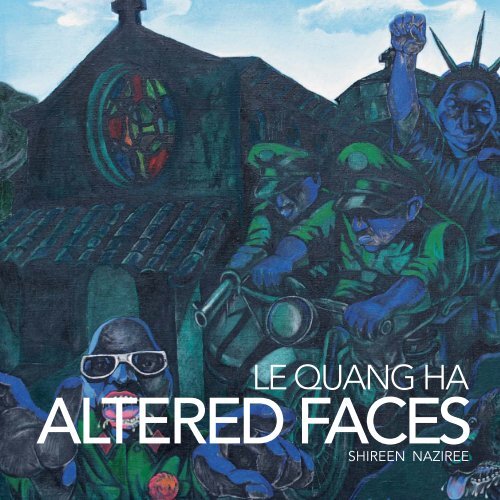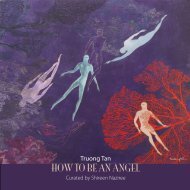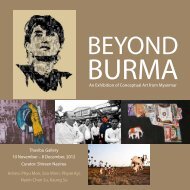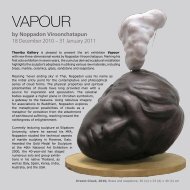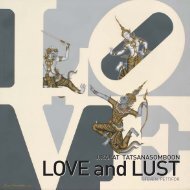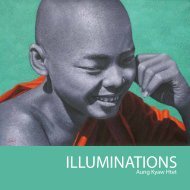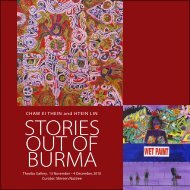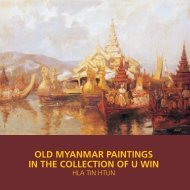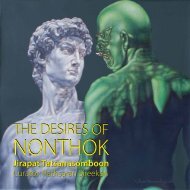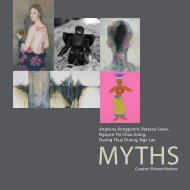Altered Faces - Thavibu Gallery
Altered Faces - Thavibu Gallery
Altered Faces - Thavibu Gallery
- No tags were found...
You also want an ePaper? Increase the reach of your titles
YUMPU automatically turns print PDFs into web optimized ePapers that Google loves.
ALTERED FACESLE QUANG HASHIREEN NAZIREE
ALTERED FACESShireen Naziree
Published 2008 by<strong>Thavibu</strong> <strong>Gallery</strong> Co. Ltd.Silom Galleria, Suite 308919/1 Silom Road, Bangkok 10500, ThailandTel. (662) 266 5454, Fax. (662) 266 5455Email. info@thavibu.com, www.thavibu.comLayout by Wanee Tipchindachaikul, Copydesk, ThailandPrinted by Amarin Printing and Publishing Public Company Limited, ThailandCopyright <strong>Thavibu</strong> <strong>Gallery</strong>All rights reserved. No part of this publication may be reproduced ortransmitted in any form or by any means, electronic or mechanical,without prior permission in writing from the publisher.
FOREWORDJørn Middelborg<strong>Thavibu</strong> <strong>Gallery</strong><strong>Thavibu</strong> <strong>Gallery</strong> has the pleasure to present the art exhibition <strong>Altered</strong> <strong>Faces</strong> by the Vietnamese artist Le Quang Ha.He has over the last decade created some of the most interesting contemporary art in Vietnam, offering a personalperspective on contemporary Vietnamese society. Thus this publication aims at profiling his new works, which willbe shown in the exhibition, in a wider context.The text has been written by the art historian and independent curator Shireen Naziree. She has written extensivelyon the contemporary art and culture of Southeast Asia and her curatorial practice has included working with someof the region’s most important artists. She has served two terms on the Board of Trustees of the National Art <strong>Gallery</strong>of Malaysia.I take this opportunity to thank Le Quang Ha for his collaboration with <strong>Thavibu</strong> <strong>Gallery</strong>, and I thank Shireen Nazireefor her contribution.I also thank Pham Long and Adrian Jones for their assistance and collectors for giving us access to their works.ALTERED FACES 3
The Pianist, 2002Oil on canvas123 x 153 cmSelf-Portrait, 1999Oil on canvas40 x 50 cmsion to another. His early works were notnecessarily shocking for their actual content,but rather for the way in which they challengedestablished ways of seeing. In hisunderstanding, art meant acknowledgingthe multiple perspectives of his subjects,whether formally, spiritually or socio-politically,and importantly acknowledging thateverybody has his or her own interpretationof truth.This acknowledgement led to the questioningof the nature and identity of Le QuangHa’s art. As powerful as it was, it was alsoproblematic for those holding the culturalbatons of power, for art becomes politicalwhen it intertwines with social relations,economics and a wide range of relatedissues. However, Le Quang Ha refutessuggestions that his art is political and offersan antidote to the literalness of his art,which is really about extending the identitybeyond the ego to other levels of transpersonalapproach. Every artist feels moresatisfied with certain choices in that he orshe paints for the sheer pleasure of it, remainingunselfconscious and unapologetic.While his works transcend the tradition andculture to which they belong, his grammarstands out even more in contrast with otherartists, particularly of his generation, workingwithin traditional psychological conventionsand allowing for a distinction between aculturally accepted subject and the achievementof deep content. Another relationshippresent in Le Quang Ha’s art is the way hissubjects subvert the exterior narratives thatsurround them and endeavour to circumscribethem. At times the fluidity of meaningmakes it notoriously difficult to pin himdown to any particular critical discourse, ashe demonstrates in his painting The Pianist(2002). This is an example of the way inwhich societies avoid or gloss over issuesthat it is really their responsibility to question.It is from this vantage that Le Quang Haexamines the relationship between politicsand contemporary art.6 ALTERED FACES
embedded in his pursuit for aesthetic independencefrom context. As he explains, “Myart does not originate out of any angst oranger. I am inspired by the life that evolvesaround me.” This degree of freedom allowshim to keep his mind clear so as to developother aesthetic forms, such as sculpture.The Spokesman, 2001Mixed mediaHeight 175 cmWhile The Three New Abundances (2006)could be perceived to carry a politicalmessage, they are better termed as socialsculptures that refer to the Vietnamesetradition of belief and worship of the threeabundances: happiness, wealth and longevity.Though his expression is surprisingly telling,what is clear is that Le Quang Ha possessesboth an extraordinary degree of skill andan acute sense of what is expressive anddramatic. Generally, he works with foundobjects collected from “rag-and-bone men”and from industrial garbage. With theseobjects, which once had a life of their ownand are no longer of use to society, he drawsparallels with cultural icons of the past thathave also become without value. Le QuangHa loves to infuse his works with a sense ofhumour that is visible in both The ThreeAbundances as well as The Spokesman(2001) a life-size figure that is programmedwith audio-visual equipment, thus implyingthe notion that a person speaks with others’words. To add to the construction of thisnarrative, Le Quang Ha used The Spokesmanto inaugurate and deliver a speech at oneof his exhibitions in Hanoi.As much as Le Quang Ha’s work representsan important contribution to Vietnamesecontemporary art, we need to understandALTERED FACES 9
Dai Can 2, 2005Oil on canvas90 x 110 cmTen Years After, 2001Oil on canvas125 x 155 cmthe meaning of the play of cultural icons inhis current practice lest these icons of realitythat remain within the circuit of Vietnamesesocio-cultural exchange be perceived merelyas vulgarity or vandalism. Dai Can 2 (2005)is typical and central to such understanding.By portraying the iconic Mona Lisa as a Communistofficial, he pushes the idea that artcan be radical and entertaining at the sametime. This desire to heighten the tensionbetween the political and rhetorical significanceof his images and icons is evident
Opera, 2003Oil on canvas200 x 240 cmthroughout Le Quang Ha’s work, althoughit is embedded in an investigation of theconsequences of global capitalism and itseffects on traditional Vietnamese values.Le Quang Ha is very much a son of Hanoiand views his city as more than a place inspace. He takes note of the continuingnarratives and the drama that constantlyunfold within this contemporary metropolis.This cluster of activity is interesting becauseit reflects the broader revival of questionsconcerning cultural values and aestheticsthat had been occurring for a very longtime, particularly in Hanoi, a city renownedas a cultural capital of Southeast Asia. TenYears After (2001) is a portrait of himselfand his wife poignantly set against a backdropof Hanoi, reminiscent of Bui XuanPhai’s (1920 - 1988) romantic renderings ofthe streets of old Hanoi.This dynamic inevitably has propelled himto consider whether the economic forcesthat have allowed for such blossoming havealso resulted in the continuing burgeoningof a new wave of economic pioneers. Theseindividuals have become pertinent to therapidly changing social environment ofHanoi, for humanity does not reside in thenew grids of the city but in culture wheretheir voices can be heard. In Opera (2003),Le Quang Ha sways between the rich historyof Vietnam with its strong link to culturalpresentations and the idea of the uncom-ALTERED FACES 11
No God - This is My Land, 2007Oil on canvas155 x 195 cm12 ALTERED FACES
promising perceptions that continue tolinger in social modernity.For Le Quang Ha, this concern is bound upwith making his art speak of his world andhis history, which are grounded in Hanoi.In No God - This is My Land (2007), he considersthe contrasts between the socialistresonance of authority and individualchoices. The general pace of the paintingis grounded in the raw energy of thenarrative. Typically crass officials with theStatue of Liberty perched on the back ofa motorbike speed through the streets ofa dark Hanoi. The contrast of the clear bluesky makes the message dense and opaquein terms of political theory.In Our Sky is Not Blue (1997), Le Quang Haindicates resonances of social discontentby exploring the relationship between consciousnessand the new social environment.He makes a good case for alignment withthe struggles and unbalanced liberalismthat have resulted from the dominantpower of authority. While there might besome debate about such abstraction andthe relationship between the privilegedand the silent majority, in this instance theblankness of the orange sky does not signifyabsence but is rather a gesture made moredramatic by threatening the viewer toexperience the same discomfort.Our Sky is Not Blue, 1997Oil on canvas110 x 125 cmALTERED FACES 13
Many of Le Quang Ha’s works appear toaddress the general penchant for acquiringwealth and the hidden links that weavethe superficial composites needed for theimplementation of power. Although manystruggle to escape this polarization, objectivelyspeaking it is not always possible.Seeing his world in terms of such a climatecreated by the ideological position of powerhas resulted in disparity and discontent.Outrage, as in The Dogs (2005), enters LeQuang Ha’s objective obliquely, as if unleashedthrough the recognition of therepression that lurks in the background asthe corrupted are soothed by money. Thisstrain of realism may be streamlined, butis vividly pictorial as the icons repeat themselves continuously, as in Dai Can 3 (2005).Dai Can 3, 2005Oil on canvas90 x 110 cm14 ALTERED FACES
The Dogs, 2005Oil on canvas155 x 1195 cmALTERED FACES 15
Terrorists or Terrorized?, 2002Oil on canvas155 x 195 cm16 ALTERED FACES
The political engagement of contemporaryart has been intense in eyeing the globalwars, terrorism and geopolitical crises thathave affected our modern history. Le QuangHa sees these events as crucial to understandingthe nature of artistic debate due tothe influence of such phenomena on hisown cultural position. Terrorists or Terrorized?(2002) is an earnest visual essay of humannature and the human possibilities ofmechanization with its desire to remain outof sight rather than test the boundaries offree speech. His visual text here is both subtlyallusive and not easily transferable.Le Quang Ha constantly mines Vietnamesecontemporary life and revels in the uncannyand grotesque, which he serves up withunmistakably apocalyptic overtones. Flying(2006) is a representation with a satiricaledge that incorporates a number of familiarmemories of Vietnam’s stormy modern history.Flying, 2006Oil on canvas200 x 240 cmALTERED FACES 17
In all his works, Le Quang Ha toys withour need to take notice of the underlyingtensions of society. Discovering the organizingdetails becomes an absorbing game.Rarely subtle, his aesthetic underscores thefact that taxonomies can be subtle andsubjective. The bright surfaces of the paintedimages belie their hidden messages, allowingthem to work their way into the viewer’sconsciousness. The tone in The Dictator 3(2004/7) is both powerful and distinctive.Le Quang Ha has ruthlessly observed theexploitive mannerisms of a propagandist. Themasked face, the clenched fist and the lightbulb are images that bring out the deeperideological implications of his subject.The Dictator 3, 2004/7Oil on canvas110 x 125 cmLe Quang Ha is careful to avoid the pitfallsthat commonly cloy sentimentalism and factualdidacticism by negotiating relationshipsbetween a rich cultural past and an identitythat represents modern economic power.Police 1, Police 4 and Police 5 (2007) arelacquer paintings that relate to those shiftingcultural conditions. By adapting a contemporarynarrative, he has desentimentalizedthe emotional pitch of this art form that isthe epitome of traditional Vietnamese artisticvalues. Where once the boundaries betweenpainting on canvas and lacquer paintingwere rigid, they now exist at either end ofa non-hierarchical axis on which his narrativecan variously overlap and merge, resulting incontrasting qualities.18 ALTERED FACES
Police 1, 2007 Lacquer and dyes on board 80 x 100 cmALTERED FACES 1514 AL-TERED FACES
20 ALTERED FACESPolice 4, 2007 Lacquer and dyes on board 80 x 100 cm
Police 5, 2007 Lacquer and dyes on board 80 x 100 cmALTERED FACES 21
22 ALTERED FACESPolice Taking a Shit, 2007 Lacquer and dyes on board 80 x 100 cm
Lady Lust, 2006Lacquer and dyes on board80 x 100 cmLady Vixen, 2005Lacquer and dyes on board80 x 100 cmALTERED FACES 23
These studies have a robust counterpart inPolice Taking a Shit (2007) where there isalso a liberating rejection of realism.Le Quang Ha reframes his subject in thisseries at will according to circumstance andnon-conformist intelligence, thus avoidingimage fatigue by emphasizing the mechanicalnature in which low-ranking authoritiesexercise their duties. Gangster (2004) isanother protest directed at his contemporaryenvironment, showing that his art is able tospeak across the barriers of knowledge directlyto people about their lives. In many ways,this series of images represents a parallelreality to his own experiences. It is from thisparallel world that he has constructed acontemporary language of transformationand fragmentation.Gangster, 2004Lacquer and dyes on board80 x 100 cmLe Quang Ha’s experiences have been boundtogether by his socio-political history and thecommon currency that makes his lacquerpaintings unique in the broader considerationsof art. Along with his non-conformistintelligence and his artistic practice thatranges over diverse cultural contexts, Ha hasset up an unavoidable tension that may beinterpreted either as liberation or as forcedinternment.24 ALTERED FACES
Sexual Power, 1998Oil on canvas110 x 125 cm26 ALTERED FACES
End of the Party, 1998Oil on canvas60 x 160 cm (triptych)But while the artist remains committed tobearing witness to the political and socialcosts of dependency, his art is simultaneouslyshadowed by an anxiety and a need toplace himself in the frame, as exemplifiedin Prison 3, but more explicitly in SexualPower (1998). This voluptuously structuredarrangement of overlapping body parts isa suggestion of his ironic humour and a veryspecific illustration of his sense of his ownsexuality. Essentially, Le Quang Ha has integratedtraditional figurative art with manyof the new basic intellectual ideas ofmodern art movements. But in conservativeVietnam, the nature of his art is still widelymisunderstood and difficult to grasp.End of the Party (1998) shares the samefundamental qualities, though his attitudeto this source of material has obviously beenfiltered to include his own experiences onceagain. Le Quang Ha’s construction of a partyscene allows a large space for ambiguouselements. He invites the viewer into a worldof hedonistic excess and in the same veinhe stresses a world of harsh reality that istinged with a certain melancholy. As is thecase when we view other of his paintings,we are conscious of the extreme complexityof his own personality and a personalvulnerability.ALTERED FACES 27
Visitor, 2004Lacquer and dyes on board30 x 40 cmThe Official, 2004Lacquer and dyes on board30 x 40 cmLady in Blue, 2004Lacquer and dyes on board30 x 40 cmBig Mouth, 2004Lacquer and dyes on board30 x 40 cmCulture Producer, 2004Lacquer and dyes on board30 x 40 cmEch, 2007Lacquer and dyes on board30 x 40 cm28 ALTERED FACES
Portraiture is one of the most powerfulart forms in the history of Western art. LeQuang Ha readily gives form to the emotionalstates of his portraits through the allegoryof physical experience. In the series ofportraits for <strong>Altered</strong> <strong>Faces</strong> he has examinedhis subjects with both humour and grace.Visitor (2004) is a portrait in lacquer of atraditional Vietnamese woman from thecountryside. He combines strong pigmentwith emphasis on the woman’s typicallyblackened teeth, traditional headgear andunexpected sunglasses. The physical presencein The Official (2004) is less literal but moremysterious. Fearlessness and perversity cometogether in his portraits. In Big Mouth(2004), manic attention to detail and personalizationunderwrites his observations onthe people who impact his culture. Theexpressive facial gestures of Culture Producer(2004) situate his palette in a frameworkthat is defined by an often eccentric renderingof specific features with disturbing andcynical overtones. His palette is so strongthat we can almost hear him talk.relates to a strong personality, whereas Ladyin Blue reflects a softer and gentler tone,filled with melancholy. But what remainsclear is Le Quang Ha’s ability to capture thedeeper essence of his subject and interpretit with a deeply felt understanding. A similardimension of understanding and observationis seen in the portrait drawing of theartist Dang Xuan Hoa (2007) whose quietand calm spirit became the visual analogueof their friendship.At an opposite end, Ech (2007) and Ladyin Blue (2004) are both presented as finelyrendered portraits, which may seem asstraight forward depictions at first. However,the monotones in Ech, and the muted tonesand the gentler strokes of Lady in Blue lendeach of these lacquer paintings a verydifferent personality: The stillness in EchDang Xuan Hoa, 2007Pencil on paper26 x 38 cmALTERED FACES 29
Dreaming, 1999Lacquer and dyes on board80 x 100 cmArt for Le Quang Ha is a tradition to be questionedand explored as part of an exercisein self-definition. As is the case for artistswho work across different artistic disciplines,his challenge is to make art that is at onceboth deeply personal and broadly meaningfulwhile addressing the issues and experiencesof the different worlds he lives in.30 ALTERED FACES
Desire, 2003Oil on canvas80 x 100 cmLe Quang Ha’s work is often rife with classicalallusions. Dreaming (1999) is a study of anude, voluptuous in its physical experience.His use of thick and vibrant brushstrokes emphasizesher rubbery flesh. In Desire (2003)the mood is different. This time round, thefocus is on the model’s nimble skeleton. Herbody is full of life and shares some of thesame defiance as the artist does in his ownideology.ALTERED FACES 31
Ech: Faraway in Thoughts, 2007Pencil on paper26 x 38 cmEch: You Cannot Fly Away, 2007Pencil on paper26 x 38 cmEch: In Repose, 2007Pencil on paper26 x 38 cmEch: A Heart’s Desire, 2007Pencil on paper26 x 38 cm32 ALTERED FACES
This relationship between the body and theunconscious demonstrates how the bodyitself experiences emotion and the liberatingpower of imagination. In another series ofnude drawings, Le Quang Ha once againcasts a sharp eye and is particularly goodat capturing the emotional essence of hissubject. The model’s pensive gaze in Ech:Faraway in Thoughts (2007) is an exampleof his association with the vitality of life.Ech: In Repose (2007) is another example ofhis gestural expressionism, whereas Ech:A Heart’s Desire (2007) is a slightly morevigorous and spontaneous depiction thatexudes a freshness and spontaneity whencompared to traditional academic nudestudies.As a response to his ongoing fervent commentaryon contemporary society, he hascommented that “the greatest forces in lifeare love and fear” and “I am always lookingat each individual with the eager hopeof finding there something of the dignityof life.” In Ech: You Cannot Fly Away (2007),Le Quang Ha once again challenges thesocial terms of Vietnamese contemporarysociety in that he underlines control anddominance over society, as suggested by themechanical wings and the downward glanceof the model.Le Quang Ha has his roots in Vietnam, aworld that is changing dramatically. Hiswork operates in a unique and metaphoricalspace fraught with the tensions andcontradictions that characterize developingnations today. By not denying the importanceof being Vietnamese nor confining himselfto the stereotype, Le Quang Ha resistsdefinition. His ambivalence and occasionalscepticism further complicate any easyreading of his work. But each of his artworksoffers us a unique way of looking at hisworld, one that is deeply felt through hisvisually moving works of art that are asprovocative as they are engaging.ALTERED FACES 33
chronologyPhoto by Le Nhat KhanhLe Quang HaBorn 1963 in Hanoi1986 - 89: Ho Chi Minh City Branch of Hanoi Industrial Fine Arts University1989 - 92: Hanoi Industrial Fine Arts UniversityBA from Hanoi Industrial Fine Arts UniversityMember of Vietnam Fine Arts AssociationSELECTED ART EXHIBITIONS1987: - National Exhibition of Young Painters - Ho Chi Minh City, Vietnam1990-91: - Fine Art Exhibitions in Hanoi, Vietnam34 ALTERED FACES
1992: - Group Show of Young Painters in Berlin, Germany- Group Show of Ten Vietnamese Painters at the French Cultural Centre - Hanoi, Vietnam- Bronze medal at Hanoi Fine Arts Association Exhibition1993: - Group Show in Beijing, China- Bronze medal at Hanoi Fine Arts Association Exhibition1994: - Group Show: War and Revolution at the National Fine Arts Exhibition- Bronze medal at Hanoi Fine Arts Association Exhibition1995: - Solo Show at Galerie Vinh Loi - Ho Chi Minh City, Vietnam- Silver medal at Vietnamese Fine Arts Association Exhibition1996: - Group Show - Zurich, Switzerland- Group Show - Berlin, Germany1997: - Group Show: The Changing Face of Hanoi - Hong Kong- Group Show - Berlin, Germany- Rencontre with Olivier Passieux - Hanoi, Vietnam1998: - Group Shows in New York, Boston and California, USA- Group Show at the Fukuoka Asian Art Museum - Fukuoka, Japan1999: - Group Show - Seoul, Korea- Group Show - Boston, USA2000: - Second Prize Winner in the National Fine Arts Exhibition2001: - Solo Show in the Vietnam Fine Art Museum - Hanoi, Vietnam- Group Show - Zug, Switzerland- Represented Vietnam at the ASEAN Art Awards - Bali, Indonesia2002: - Launched website www.lequangha.com2004: - Solo Show: Le Quang Ha at L’Espace - Hanoi, Vietnam- Group Show in at Hotel Arte - Olten, Switzerland2005: - Group Show: The Ten Courts of the Kings of Hell, Vietnam Past and Present at Bankside <strong>Gallery</strong> - London, UK2006: - Group Show at the Fielding-Lecht <strong>Gallery</strong> - Austin, Texas, USA2008: - Solo Show: <strong>Altered</strong> <strong>Faces</strong> at <strong>Thavibu</strong> <strong>Gallery</strong> - Bangkok, ThailandLe Quang Ha lives with his wife and two sons in Hanoi.MUSEUM COLLECTIONSSingapore Art MuseumFukuoka Asian Art Museum, JapanALTERED FACES 35


